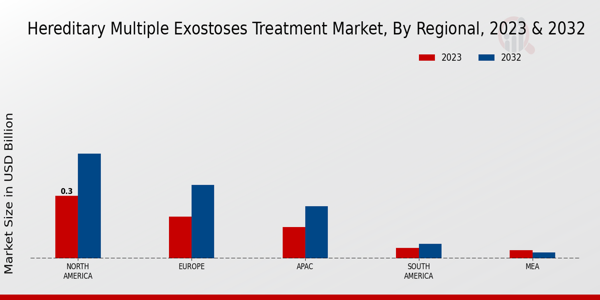Rising Healthcare Expenditure
The Global Hereditary Multiple Exostoses Treatment Market Industry is benefiting from rising healthcare expenditure across various regions. Governments and private sectors are investing heavily in healthcare infrastructure and services, which is facilitating access to advanced treatments for HME. Increased funding for research and development is also contributing to the emergence of innovative therapies. For instance, countries with robust healthcare systems are prioritizing the treatment of rare diseases, including HME, thereby expanding the market. This trend is expected to bolster the market's growth trajectory, as higher healthcare spending correlates with improved access to effective treatment options.
Advancements in Treatment Modalities
Innovations in treatment modalities are significantly influencing the Global Hereditary Multiple Exostoses Treatment Market Industry. Recent advancements in surgical techniques, such as minimally invasive procedures and improved orthopedic interventions, have enhanced patient outcomes. Furthermore, the development of targeted therapies and biologics is providing new avenues for managing HME. These advancements not only improve the quality of life for patients but also encourage healthcare providers to adopt these novel treatments. As a result, the market is poised for growth, with a projected compound annual growth rate (CAGR) of 5.49% from 2025 to 2035, reflecting the increasing adoption of advanced treatment options.
Emerging Markets and Global Expansion
Emerging markets are becoming increasingly relevant in the Global Hereditary Multiple Exostoses Treatment Market Industry. Countries in Asia-Pacific and Latin America are experiencing economic growth, leading to improved healthcare access and infrastructure. As these regions develop, there is a growing demand for specialized medical treatments, including those for HME. Pharmaceutical companies are recognizing the potential in these markets and are expanding their operations to cater to the rising patient population. This expansion is anticipated to drive market growth, as it opens new avenues for treatment and increases the availability of therapeutic options for patients suffering from HME.
Growing Awareness and Education Initiatives
Growing awareness and education initiatives regarding hereditary multiple exostoses are playing a crucial role in the Global Hereditary Multiple Exostoses Treatment Market Industry. Healthcare organizations and patient advocacy groups are actively promoting knowledge about HME, its symptoms, and available treatment options. This increased awareness is leading to earlier diagnosis and intervention, which is essential for better patient outcomes. As more individuals become informed about HME, the demand for effective treatment solutions is likely to rise. Consequently, this trend is expected to contribute positively to market growth, as more patients seek specialized care and management strategies.
Increasing Prevalence of Hereditary Multiple Exostoses
The Global Hereditary Multiple Exostoses Treatment Market Industry is witnessing a notable increase in the prevalence of hereditary multiple exostoses (HME). This condition, characterized by the formation of multiple benign bone tumors, affects individuals globally, with estimates suggesting that it occurs in approximately 1 in 2,000 to 1 in 5,000 live births. As awareness of HME grows, more patients are seeking treatment options, thereby driving market growth. The increasing number of diagnosed cases is expected to contribute to the market's expansion, with projections indicating a market value of 0.82 USD Billion in 2024, potentially reaching 1.48 USD Billion by 2035.





















Leave a Comment